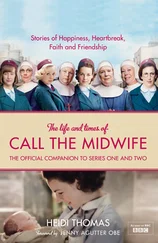A bell rang. She smiled. “It is time for Compline. I must go. We will meet in the morning. I hope you have a restful night.”
The impact Sister Julienne made upon me - and, I discovered, most people - was out of all proportion to her words or her appearance. She was not imposing or commanding, nor arresting in any way. She was not even particularly clever. But something radiated from her and, ponder as I might, I could not understand it. It did not occur to me at the time that her radiance had a spiritual dimension, owing nothing to the values of the temporal world.
It was about 6 a.m. when I arrived back at Nonnatus House after Muriel’s delivery, and I was ravenous. A night’s work, and a six to eight mile cycle ride can sharpen a young appetite like nothing else. The house was quiet when I entered. The nuns were in Chapel, and the lay staff not yet up. I was tired, but I knew that I had to clean my delivery bag, wash and sterilise my instruments, complete my notes and leave them on the office desk before I could eat.
Breakfast was laid out in the dining room, and I would take mine first, then go to bed for a few hours. I raided the larder. A pot of tea, boiled eggs, toast, home-made gooseberry jam, cornflakes, home-made yoghurt and scones. Heaven! Nuns always have a lot of home-made food, I had discovered. The preserves came from the many church bazaars and sales that seemed to go on throughout the year. The delicious cakes and biscuits and crunchy bread were made either by the nuns or by the many local women who came in to work at Nonnatus House. Any staff who had missed a meal through being called out had a free run of the larder. I was deeply grateful for this liberality, which was so unlike hospitals, where you had to plead for a bit of food if you had missed a meal for any reason.
It was a royal feast. I left a note asking to be called at about 11.30 a.m., and persuaded my tired legs to carry me up to my bedroom. I slept like a baby, and when someone roused me with a cup of tea, I couldn’t remember where I was. The tea reminded me. Only the kind Sisters would send a cup of tea up to a nurse who had been working all night. In hospital it would be a bang on the door, and that would be that.
Downstairs I looked at the daybook. Only three calls before lunch. One to Muriel, and two visits to patients in the tenements that I would pass on the way. Four hours of sleep had refreshed me completely, and I got out the bike and cycled off in high spirits in the sunshine.
The tenements were always grim looking, whatever the weather. They were constructed as a four-sided building with an opening on one side, all the flats faced inwards. The buildings were about six storeys high, and sunlight seldom reached the inner courtyard, which was the social centre for the tenement dwellers. The courtyard contained all the washing lines and as there were literally hundreds of flats in each block, they were never without loads of washing flapping in the wind. The dustbins were also in the courtyard.
In the times I am writing about, the 1950s, there was a lavatory and running cold water in each flat. Before the introduction of these facilities, the lavatories and water were in the courtyard, and everyone had to go down to use them. Some of the tenements still retained the lavatory sheds, which were now used to house bikes or motor cycles. There did not seem many of them - perhaps three dozen at the most, and I wondered how there could have been enough lavatories for the occupants of about five hundred flats.
I threaded my way through the washing, and reached the stairway that I wanted. All the stairways were external, made of stone steps, and led up to a balcony, facing inwards, which ran the length of the building, going round all the corners, continuously. Each of the flats led off this balcony. Whereas the inner courtyard was the centre of social life, the balconies were the lanes, teeming with life and gossip. The balconies for the tenement women were equivalent to the streets of the terraced house dwellers. So close was the living space, that I doubt if anyone could get away with anything without all the neighbours knowing. The outside world held very little interest for the East Enders, and so other peoples’ business was the primary topic of conversation - for most it was the only interest, the only amusement or diversion. It is not surprising that savage fighting frequently broke out in the tenements.
The tenements looked unusually cheerful in the noonday sun when I arrived that day. I picked my way through the litter and dustbins and washing in the courtyard. Small children crowded around. The midwife’s delivery bag was an object of intense interest - they thought we carried the baby in it.
I found my entry, and climbed the five storeys to the flat I wanted.
All the flats were more or less the same: two or three rooms leading off each other. A stone sink in one corner of the main room; a gas stove and a cupboard constituting the kitchen. The lavatories, when they were introduced, had to be installed near the water supply, so they were situated in a corner, near to the sink. The installation of lavatories in each flat had been a great leap forward in public hygiene, because it improved the conditions in the courtyard. It also avoided the necessity of chamber pots in every flat which had to be emptied daily, the women carrying them downstairs to the emptying troughs. The ordure in the courtyards used to be disgusting, I was told.
The tenements of London’s East End were built around the 1850s, mainly to house the dock workers and their families. In their day, they were probably considered to be adequate housing, quite sufficient for any family. They were certainly an improvement on the mud-floor hovels that they replaced, which barely protected a family from the elements. The tenements were brick built with a slate roof. Rain did not penetrate and they were dry inside. I have no doubt that 150 years ago, they were ever considered to be luxurious. A large family of ten to twelve people in two or three rooms would not have been judged as overcrowding. After all, the vast majority of mankind has lived in such conditions throughout history.
But times change, and by the 1950s the tenements were considered to be slum areas. The rents were a lot cheaper than the terraced houses, and consequently only the poorest families, those least able to cope, entered the tenements. Social law seems to suggest that the poorest families are often the ones that produce the greatest number of children, and the tenements were always teeming with them. Infectious diseases ran through the buildings like wildfire. So did the pests: fleas, body lice, ticks, scabies, crabs, mice, rats, and cockroaches. The pest control men from the council were always busy. The tenements were deemed unfit for human habitation and evacuated in the 1960s, and stood empty for over a decade. They were finally demolished in 1982.
Edith was small and stringy, and as tough as old boots. She looked a good deal older than forty years. She had brought up six children. During the war they had been bombed out of a terraced house, but it had not been a direct hit, and the family had survived. The children were then evacuated. Her husband was a dock labourer, and she was a munitions worker. After the bombing, she and her husband had moved into the tenements, which were cheaper to rent. They both lived there throughout the entire Blitz, and miraculously the tenements, which were the most densely populated dwellings, were not hit. Edith did not see her children for five years, but they were reunited in 1945. The family continued to live in the tenements, because of the rent, and because they had become used to the life. How anyone could manage in two rooms with six growing children was always beyond my understanding. But they did, and thought nothing of it.
Читать дальше












